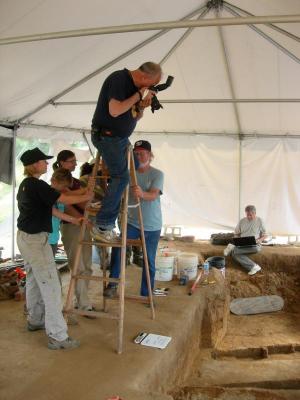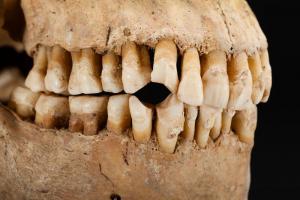Well-preserved burial sites of 11 early colonial Delawareans were discovered in 2012 on land near Rehoboth Beach Country Club, and could offer an unprecedented window into 17th century life in the Cape Region.
Secretary of State Jeff Bullock, Dr. Douglas Owsley of the Smithsonian Institute and members of the Delaware archaeological community revealed their findings at an event held Dec. 6 at the Rehoboth Beach Museum.
“I work across the Chesapeake [Region] and these are without a doubt the best-preserved burials I’ve seen in the Chesapeake area,” said Owsley, who leads the Division of Physical Anthropology at the Smithsonian National Museum of Natural History.
Owsley has been working in Jamestown since 1996 and St. Mary’s City since 1992. He said the quality of care used by Delaware archaeologists as well as the exceptional preservation of the burial chambers provides a significant opportunity to learn more about the individuals buried at Avery’s Rest. He is confident most of the individuals will be identified in the future.
Avery’s Rest history
John Avery owned 800 acres near the Rehoboth Bay in the 17th century, including the land where the burials were discovered. He moved to the area with his wife Sarah about 1674. He lived there until his death in 1682. The land went unoccupied until 1698, when John and Sarah’s youngest daughter, Jemima, and her husband John Morgan moved onto the property.
Remnants of the Avery homestead were discovered in 1976 and the site was later listed on the National Register of Historic Places in 1978.
The Delaware Division of Historical and Cultural Affairs raised concerns over proposed development in 2005, and a year later the state gained permission from the landowners to survey the site.
Surveys and excavations were carried out over the next several years before the first of the 11 burials was discovered in September 2012.
After obtaining consent from next-of-kin and landowners, the remains were removed and transferred to the Smithsonian for further analysis. In March 2017, the Smithsonian confirmed age, gender and ethnicity of the burials.
Dating the remains
The remains were discovered in two areas within a burial site of 55 feet by 20 feet. Researchers believe the earliest death occurred about 1683, which could be John Avery. It is believed the burials range from 1683 to about 1715.
Eight of the burials contain remains of persons of European descent, while three others, including a 5-year-old child, are of African descent. It is believed the three African individuals were slaves.
Researchers used historic artifacts to piece together a timeline for the burials, said Daniel Griffith of the Archaeological Society of Delaware. Among the items found at the site was a white clay tobacco pipe with an “EB” maker’s mark stamped on the heel. Research found it was made by Edward Bird, a pipemaker in Amsterdam from 1630 to 1665.
“That confirms the burials are after 1665 at the latest,” he said. “This is consistent with burial during the Avery family period.”
Researchers also found 17th century glass throughout the site.
English stoneware was found in the top soil all around the burials, but it was not found in the grave shafts. Because the presence of English stoneware did not appear in the English colonies until about 1690, the burials predate the stoneware, Griffith said.
Who are they?
Because the condition of the burials was so exceptional, Owsley and his team were able to learn a lot about the people who lived in the area more than 300 years ago.
“Avery’s Rest is particularly important because it adds to the biological data on the varied experiences of the colonists in the Chesapeake,” Owsley said. “It gives us a very personal look at the life stories of these individuals in the Delaware frontier environment.”
The adults found range in age from 27 to about 60 years old.
All individuals at the site show signs of heavy physical labor and likely suffered from back problems.
Owsley said 30 percent of the teeth analyzed suffered from tooth decay, and about 20 percent of the teeth in their mouths at the time of their death were actively abscessing.
“You only need to have one to know what that’s like,” Owsley said. “There are going to be individuals in this series that the oral health problems were their undoing.”
The seven adult men recovered all showed signs of heavy tobacco use. Owsley said pipe stem grooves were very evident in each of their mouths.
“These pipes were harder than their teeth, so it wears away their teeth,” he said. Photographs show gaps in the row of teeth where a pipe would lay. Most individuals had two pipe stem grooves, one on each side, but one of the men had four, Owsley said.
In terms of identification, Owsley said, the team was able to get very complete mitochondrial DNA, which is DNA passed from the mother to her sons and daughters.
“We have four individuals at this site that share the same type of mitochondrial DNA,” Owsley said. “That is spectacular because they will lead next to more complete genomic information and testing.”
Owsley is confident the 60-year-old female found at the site is Sarah Avery, John’s wife. One of her daughters is likely present at the site too. Since Sarah’s daughter Jemima lived at the site, he said, he believes it to be her.
Work is ongoing and, Owsley said, more will be learned as more tests are conducted.
“We’ll ultimately get the male Y chromosome data and triangulate who’s related,” he said. “We’ll find out the dad. We’ll find out whether any males at this site are related.”
Slaves continues story of Black Anthony
Dr. Angela Winand, head of the Mitchell Center for African American Heritage and Diversity Programs at the Delaware Historical Society, said the presence of three individuals of African descent will add to the story of the early black community in Delaware.
“The story we try to tell to our visitors when they come into the Mitchell Center is a story that talks about the trauma and disruption of the slave trade,” she said. “But, more importantly, it allows visitors to reflect on the survival of people of African descent and their contributions from the moment of Black Anthony’s arrival through to present day.”
Black Anthony is believed to be the first black in Delaware, captured in 1638 and delivered to Fort Christiana in 1639. He later served as a special assistant to Gov. Johan Printz.
“It’s great to know Anthony has company now, and not only can we augment that story in terms of going through the Middle Passage, arriving in Delaware and contributing to the growth of what will become the First State, but that we’re also able to share with our visitors this continuing story of deep contributions and community building through the Avery’s Rest site,” Winand said.
All of the remains found at Avery’s Rest will stay in the custody of the Smithsonian, where they will assist ongoing work to trace the genetic and anthropological history of early colonial settlers of the Chesapeake region.
In Delaware, the Division of Historical and Cultural Affairs will continue to work with the Delaware Historical Society and the Archaeological Society of Delaware to craft a plan to exhibit the Avery’s Rest findings for the public.
Nick Roth is the news editor. He has been with the Cape Gazette since 2012, previously covering town beats in Milton and Lewes. In addition to serving on the editorial board and handling page layout, Nick is responsible for the weekly Delaware History in Photographs feature and enjoys writing stories about the Cape Region’s history. Prior to the Cape Gazette, Nick worked for the Delmarva Media Group, including the Delaware Wave, Delaware Coast Press and Salisbury Daily Times. He also contributed to The News Journal. Originally from Boyertown, Pa., Nick attended Shippensburg University in central Pennsylvania, graduating in 2007 with a bachelor’s degree in journalism. He’s won several MDDC awards during his career for both writing and photography. In his free time, he enjoys golfing, going to the beach with his family and cheering for Philadelphia sports teams.


























































